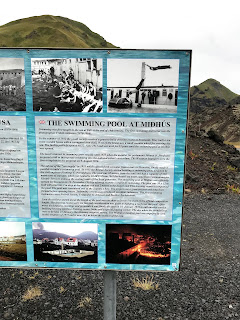Ascent
All the mountains here are gray, the volcano is red. It lies a couple hundred meters from town. 3/4 of the volcano blew up in a fiery rage in 1973. The lava threatened to destroy the town, but the fishermen were able to evacuate everybody to safety without Pompeii like casualties. The road to the volcano is very short.. it ends at the low side of the crater wall. A couple hundred feet up in this red gravel like material you see the entire rim. Completely blown up. Nothing is in the middle of the crater, just more red gravel, a few stray bunches of grass. I ascended to the top. There were a couple people up there when I started heading up. The sun sets super late here so it was perfect.
At the top you see verdant green hills on one side, lava flows to the ocean on another side, and the crater rim that lowers in the direction of town on another side. I couldn’t believe my luck. Good weather, sunset light making the red rocks glow even more red, contrasting to green grass mountains in the ocean and land beyond.
The wind was very strong. Like being on knife edge of Katahdin, the winds were that strong. It blew my hat down one side... I was able to recover it luckily.... when I descended it was like skiiing down gunung Batur with the danish... except red gravel instead of black.
Lava fields
“An old prophecy had said that once three specific things had happened in Vestmannaeyjar, pirates would again raid the island. Those three things were first, that the town would extend west of the landmark, Hásteinn, second, that the freshwater pool of Vilpa would no longer be in use, and third, that the son of a bishop would be ordained as a priest for the island. Early in 1973 these three things came to pass: the town extended west of Hásteinn, the Vilpa pool was filled in after the drowning there of a young child, and Karl Sigurbjörnsson, the son of a bishop (and the present bishop of Iceland) was given a position of service at the church in Vestmannaeyjar.”
January 23, 1973
Pirates in the form of lava flows and noxious gasses and spewing rocks rained down on Vestmannaeyjar. Due to stormy weather the day before, all of the island’s fishing fleet was in the harbor so that most of the inhabitants were able to be quickly. Today, on the east side of town, there is a narrow stair up a rocky mass into the red lava fields of eldfell. Just to the right of the rocky mass were the houses that were spared by the eruption. The rocky mass is 10-15 meters high.. a lava field that covered 1/3 of the town, destroying the oldest section of town. The townspeople fought valiantly against the lava by spraying it with sea water to halt its march to prevent it from filling the harbor and destroying their ocean based economy.
On the trail are wooden markers of streets that one stood proudly for hundreds of years. A sign showing a buried swimming pool sits like a tombstone. Plaques mounted to some igneous rocks are like grave markers that record notable historical inhabitants and buried houses below. The day before, I reached the summit of the eldfell and beheld beautiful panoramas of sunset without any memory. This morning I walked in the lava fields below that blanketed the old part town and walked on top of history and rebirth. Moss and trees have colonized the volcanic rocks creating the typical Bjork Icelandic landscape. Soft, rugged, unpredictable, elemental, and growing out of the harshest conditions. Many residents did not return after the eruption... too traumatized by the events. New people arrived and rebuilt the town... like new moss colonizing the lava rocks... another layer of history on this island.



No comments:
Post a Comment